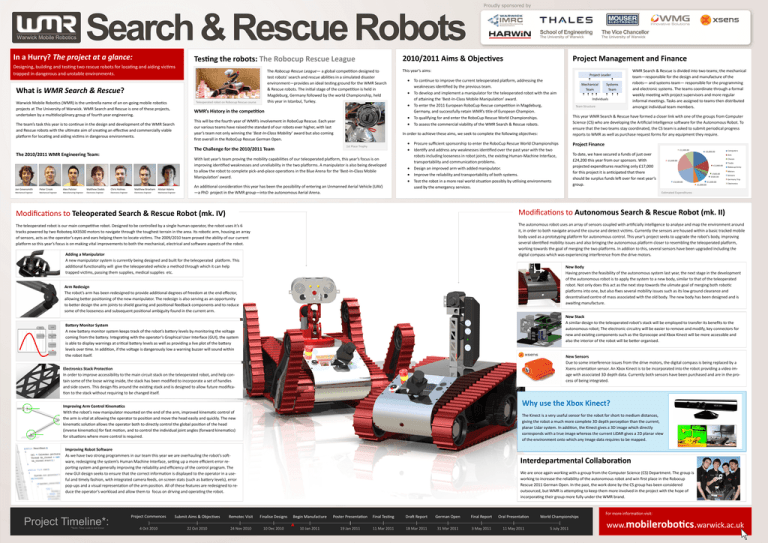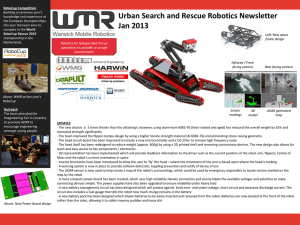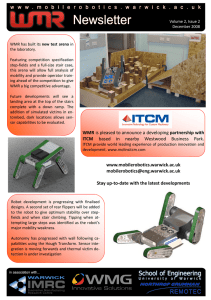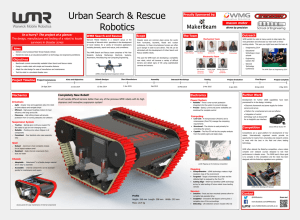2010/2011 Aims & Objectives Testing the robots: The Robocup Rescue League
advertisement

In a Hurry? The project at a glance: 2010/2011 Aims & Objectives Testing the robots: The Robocup Rescue League Designing, building and testing two rescue robots for locating and aiding victims trapped in dangerous and unstable environments. The Robocup Rescue League— a global competition designed to test robots’ search and rescue abilities in a simulated disaster environment—provides an ideal testing ground for the WMR Search & Rescue robots. The initial stage of the competition is held in Magdeburg, Germany followed by the world Championship, held this year in Istanbul, Turkey. What is WMR Search & Rescue? Teleoperated robot on Robocup Rescue course Warwick Mobile Robotics (WMR) is the umbrella name of an on-going mobile robotics projects at The University of Warwick. WMR Search and Rescue is one of these projects, undertaken by a multidisciplinary group of fourth year engineering. This year’s aims: Project Leader To continue to improve the current teleoperated platform, addressing the WMR’s History in the competition This will be the fourth year of WMR’s involvement in RoboCup Rescue. Each year our various teams have raised the standard of our robots ever higher, with last year’s team not only winning the ‘Best-In-Class Mobility’ award but also coming first overall in the RoboCup Rescue German Open. The team’s task this year is to continue in the design and development of the WMR Search and Rescue robots with the ultimate aim of creating an effective and commercially viable platform for locating and aiding victims in dangerous environments. The 2010/2011 WMR Engineering Team: Peter Crook Alex Palister Matthew Dodds Chris Holmes Matthew Broxham Alistair Adams Mechanical Engineer Mechanical Engineer Manufacturing Engineer Electronics Engineer Electronics Engineer Electronics Engineer Mechanical Engineer An additional consideration this year has been the possibility of entering an Unmanned Aerial Vehicle (UAV) —a PhD project in the WMR group—into the autonomous Aerial Arena. Systems Team Individuals Team Structure WMR Search & Rescue is divided into two teams; the mechanical team—responsible for the design and manufacture of the robots— and systems team— responsible for the programming and electronic systems. The teams coordinate through a formal weekly meeting with project supervisors and more regular informal meetings. Tasks are assigned to teams then distributed amongst individual team members. This year WMR Search & Rescue have formed a closer link with one of the groups from Computer Science (CS) who are developing the Artificial Intelligence software for the Autonomous Robot. To ensure that the two teams stay coordinated, the CS team is asked to submit periodical progress reports to WMR as well as purchase request forms for any equipment they require. Procure sufficient sponsorship to enter the RoboCup Rescue World Championships Identify and address any weaknesses identified over the past year with the two With last year’s team proving the mobility capabilities of our teleoperated platform, this year’s focus is on improving identified weaknesses and unreliability in the two platforms. A manipulator is also being developed to allow the robot to complete pick-and-place operations in the Blue Arena for the ‘Best-In-Class Mobile Manipulation’ award. Jon Greensmith Mechanical Team weaknesses identified by the previous team. To develop and implement a manipulator for the teleoperated robot with the aim of attaining the ‘Best-In-Class Mobile Manipulation’ award. To enter the 2011 European RoboCup Rescue competition in Magdeburg, Germany, and successfully retain WMR’s title of European Champion. To qualifying for and enter the RoboCup Rescue World Championships. To assess the commercial viability of the WMR Search & Rescue robots. In order to achieve these aims, we seek to complete the following objectives: 1st Place Trophy The Challenge for the 2010/2011 Team Project Management and Finance Project Finance £1,500.00 To date, we have secured a funds of just over £24,200 this year from our sponsors. With projected expenditures reaching only £17,000 for this project it is anticipated that there should be surplus funds left over for next year’s group. robots including looseness in robot joints, the existing Human-Machine Interface, transportability and communication problems. Design an improved arm with added manipulator. Improve the reliability and transportability of both systems. Test the robot in a more real world situation possibly by utilising environments used by the emergency services. £3,000.00 Computers Arm Chassis £3,500.00 Tracks £2,000.00 Robocup Entry Motors £500.00 £500.00 Sensors Germany Trip £3,500.00 £1,500.00 £1,000.00 Electronics Estimated Expenditures Modifications to Teleoperated Search & Rescue Robot (mk. IV) Modifications to Autonomous Search & Rescue Robot (mk. II) The teleoperated robot is our main competitive robot. Designed to be controlled by a single human operator, the robot uses it’s 6 tracks powered by two Roboteq AX3500 motors to navigate through the toughest terrain in the area. Its robotic arm, housing an array of sensors, acts as the operator’s eyes and ears helping them to locate victims. The 2009/2010 team proved the ability of our current platform so this year’s focus is on making vital improvements to both the mechanical, electrical and software aspects of the robot. The autonomous robot uses an array of sensors coupled with artificially intelligence to analyse and map the environment around it, in order to both navigate around the course and detect victims. Currently the sensors are housed within a basic tracked mobile body used as a prototyping platform for autonomous control. This year’s project seeks to upgrade the robot’s body, improving several identified mobility issues and also bringing the autonomous platform closer to resembling the teleoperated platform, working towards the goal of merging the two platforms. In addiion to this, several sensors have been upgraded including the digital compass which was experiencing interference from the drive motors. Adding a Manipulator A new manipulator system is currently being designed and built for the teleoperated platform. This additional functionality will give the teleoperated vehicle a method through which it can help trapped victims, passing them supplies, medical supplies etc. New Body Having proven the feasibility of the autonomous system last year, the next stage in the development of the autonomous robot is to apply the system to a new body, similar to that of the teleoperated robot. Not only does this act as the next step towards the ulimate goal of merging both robotic platforms into one, but also fixes several mobility issues such as its low ground clearance and decentralised centre of mass associated with the old body. The new body has been designed and is awaiting manufacture. Arm Redesign The robot’s arm has been redesigned to provide additional degrees of freedom at the end effector, allowing better positioning of the new manipulator. The redesign is also serving as an opportunity to better design the arm joints to shield gearing and positional feedback components and to reduce some of the looseness and subsequent positional ambiguity found in the current arm. New Stack A similar design to the teleoperated robot’s stack will be employed to transfer its benefits to the autonomous robot; The electronic circuitry will be easier to remove and modify, key connectors for new and existing components such as the Gyroscope and Xbox Kinect will be more accessible and also the interior of the robot will be better organised. Battery Monitor System A new battery monitor system keeps track of the robot’s battery levels by monitoring the voltage coming from the battery. Integrating with the operator’s Graphical User Interface (GUI), the system is able to display warnings at critical battery levels as well as providing a live plot of the battery levels over time. In addition, if the voltage is dangerously low a warning buzzer will sound within the robot itself. New Sensors Due to some interference issues from the drive motors, the digital compass is being replaced by a Xsens orientation sensor. An Xbox Kinect is to be incorporated into the robot providing a video image with associated 3D depth data. Currently both sensors have been purchased and are in the process of being integrated. Electronics Stack Protection In order to improve accessibility to the main circuit stack on the teleoperated robot, and help contain some of the loose wiring inside, the stack has been modified to incorporate a set of handles and side covers. This design fits around the existing stack and is designed to allow future modification to the stack without requiring to be changed itself. Why use the Xbox Kinect? Improving Arm Control Kinematics With the robot’s new manipulator mounted on the end of the arm, improved kinematic control of the arm is vital at allowing the operator to position and move the head easily and quickly. The new kinematic solution allows the operator both to directly control the global position of the head (inverse kinematics) for fast motion, and to control the individual joint angles (forward kinematics) for situations where more control is required. The Kinect is a very useful sensor for the robot for short to medium distances, giving the robot a much more complete 3D depth perception than the current, planar Lidar system. In addition, the Kinect gives a 3D image which directly corresponds with a true image whereas the current LiDAR gives a 2D planar view of the environment onto which any image data requires to be mapped. Improving Robot Software As we have two strong programmers in our team this year we are overhauling the robot’s software, redesigning the system’s Human Machine Interface, setting up a more efficient error reporting system and generally improving the reliability and efficiency of the control program. The new GUI design seeks to ensure that the correct information is displayed to the operator in a useful and timely fashion, with integrated camera feeds, on screen stats (such as battery levels), error pop-ups and a visual representation of the arm position. All of these features are redesigned to reduce the operator’s workload and allow them to focus on driving and operating the robot. Project Timeline*: *Note: Time scale is not linear Interdepartmental Collaboration We are once again working with a group from the Computer Science (CS) Department. The group is working to increase the reliability of the autonomous robot and win first place in the Robocup Rescue 2011 German Open. In the past, the work done by the CS group has been considered outsourced, but WMR is attempting to keep them more involved in the project with the hope of incorporating their group more fully under the WMR brand. Project Commences Submit Aims & Objectives Remotec Visit Finalise Designs Begin Manufacture Poster Presentation Final Testing Draft Report German Open Final Report Oral Presentation World Championships 4 Oct 2010 22 Oct 2010 24 Nov 2010 10 Dec 2010 10 Jan 2011 19 Jan 2011 11 Mar 2011 18 Mar 2011 31 Mar 2011 3 May 2011 11 May 2011 5 July 2011 For more information visit: www.mobilerobotics.warwick.ac.uk




